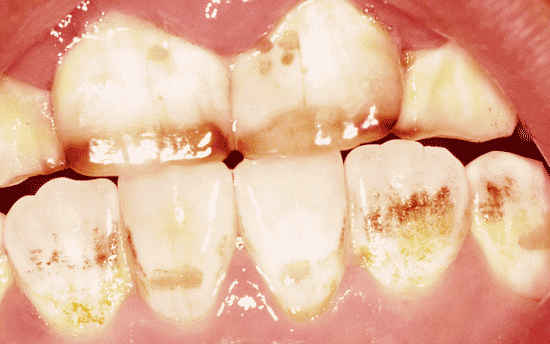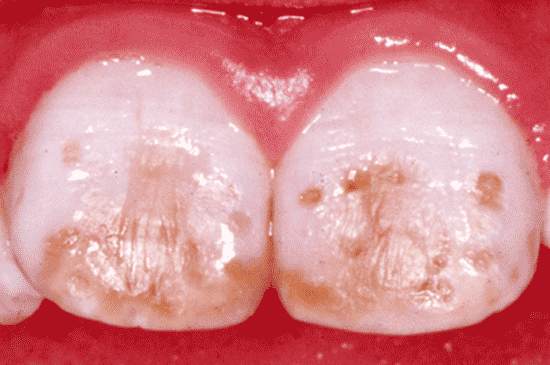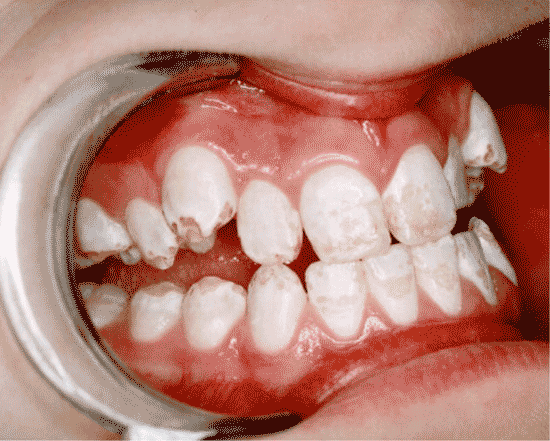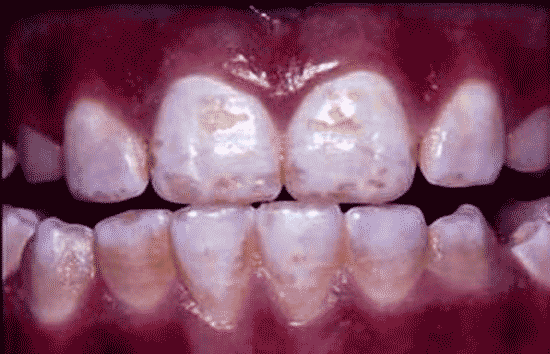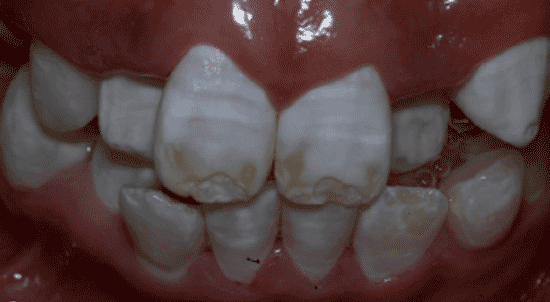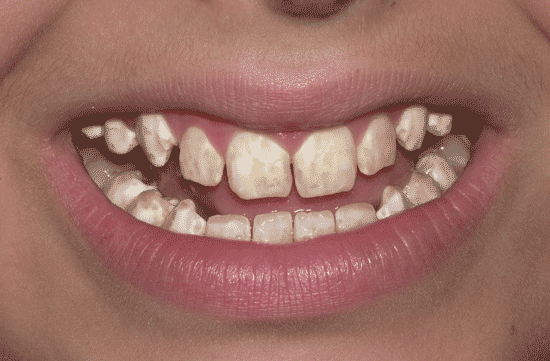The Fluorosis Timeline
1974: The Safe Drinking Water Act is passed requiring EPA to set federally enforceable standards that protect against all “known or anticipated adverse effects.”
1975: EPA sets a federally-enforceable Maximum Contaminant Level (MCL) of fluoride to protect against moderate/severe dental fluorosis. The MCL is set at 1.4 – 2.4 ppm fluoride – the same standard issued as a recommended guideline by the Public Health Service in 1962.
April 17, 1979: In response to inquiries from Senator Strom Thurmond of South Carolina about whether fluoride could be removed from the federally-enforceable standards (i.e. “primary standards”), EPA responds: “It is not appropriate to remove fluoride from the primary standards because it can cause adverse health effects (moderate to severe dental fluorosis) at levels found in some drinking water.” [See letter]
March 1980: The American Dental Association (ADA) announces its opposition to the EPA regulating fluoride in water supplies. According to ADA, “there is no evidence implicating naturally occurring fluorides as a health hazard” and the “labeling of excess fluoride as a contaminant will undermine the efforts of the dental profession and government in promoting fluoridation of community water supplies.” [See article]
March 23-26, 1980: Following the ADA’s announcement, the Association of State and Territorial Dental Directors (ASTDD) passes a resolution stating its opposition to EPA’s regulation of fluoride in water. According to the ASTDD, dental fluorosis is not a “health hazard,” and that the “continued labeling of fluoride as a contaminant and health hazard will undoubtedly undermine the efforts of the dental profession to promote fluoridation of community water supplies.” [See resolution]
July 4, 1980: In a letter to the American Dental Association, the then Surgeon General, Julius Richmond, upholds EPA’s view that severe fluorosis can damage teeth. According to Richmond, “[S]evere levels of fluorosis are characterized by anatomical defects in dental enamel. The gross enamel defects that often occur with this level of fluorosis not only are unattractive but may also require clinical treatment.”
1981: The South Carolina Department of Health and Environmental Control files a petition requesting EPA remove fluoride from the federally enforceable standards. [See Washington Post article]
1981: EPA asks Surgeon General to advise EPA on the “health aspects of dental fluorosis.”
April-May 1982: An early draft of the Surgeon General’s report on dental fluorosis is distributed to the ADA and the ASTDD for their comment. The ASTDD strongly objects to the report’s concession that “the possibility of some adverse oral change cannot be dismissed.” ASTDD’s request is upheld. The sentence is deleted from the final report. [See ATSDD’s response | See ADA’s response]
July 30, 1982: The Surgeon General, C. Everett Koop, sends a letter to EPA summarizing the findings of the PHS report on dental fluorosis. According to Koop, “No sound evidence exists which shows that drinking water with the various concentrations of fluoride found naturally in public vater supplies in the US has any adverse effect on dental health as measured by loss of function and tooth mortality.” [See letter]
April 18-19, 1983: An Ad Hoc Committee of the Surgeon General’s office, requested by EPA to review the “Non-Dental Health Effects of Fluoride” convenes in Washington D.C for a 2 day hearing. At the close of the hearing, the Panel votes 12-2 to recommend a primary standard of 1.4 to 2.4 ppm in order to prevent moderate/severe dental fluorosis. The majority of the panel agrees that severe (stage IV) and moderate (stage III) fluorosis should be regarded as an adverse health effect. To quote:
“I think it is fairly close to unanimous that we all agreed that dental fluorosis problem is, in fact, has medical ramifications. Almost everybody agreed on that. Not knowing where bone disease begins at any age, what you are saying is that there is something going on in the teeth, then the likelihood is that there is something going on in the bone. You don’t know that it is there, you don’t know that it is not there.” Dr. Robert Marcus, p. 455-456.
“We regard dental fluorosis in the Stage III level as an adverse health effect and that is what the regulation has been aimed to prevent. That is really what we have done.” – Dr. Michael Kleekoper, p. 472.
“I think the sense of the committee is that the cosmetic effect represents an adverse health effect, that this is psychologically damaging. People walk around covering their mouths.” – Dr. Robert Marcus, p. 473.
“You would have to have rocks in your head, in my opinion, to allow your child much more than two parts per million.” – Dr. Stanley Wallach, p. 416.
May 26, 1983: The Chairman of the Surgeon General’s Ad Hoc Committee circulates a draft report of the Panel’s conclusions. Consistent with the conclusions of the Committee on April 19th, the draft report concludes:
“While not specifically addressing dental effects there was a consensus that mottling or pitting of teeth could represent as yet unknown skeletal effects in children and that severe dental fluorosis per se constitutes an adverse health effect that should be prevented.” [See draft report]
June 1, 1983: Following receipt of the Ad Hoc Committee’s Draft Report, John Small of the NIDR writes to the Chaiman warning him about the conclusion that dental fluorosis is an adverse health effect. According to Small:
“I think we as a committee need to recognize that this is a departure from the conclusions reached through fifty years of PHS-sponsored epidemiological and clinical investigations. I too feel that moderate and severe dental fluorosis are to be avoided, but am less certain that we should invert history to accomplish that end.” [See Small’s letter]
Sept 26, 1983: The Final Report of the Surgeon General’s Ad Hoc Committee is submitted. All mention of dental fluorosis as being an adverse health effect is removed. Moderate/severe fluorosis is described instead as “uncosmetic”, a change consistent with the Surgeon General’s goal of avoiding federally-enforceable regulations on dental fluorosis. [See Final Report]
A later investigation by journalist Daniel Grossman finds that the majority of Committee members were never informed of the change to the committee’s conclusions. According to Grossman:
“When contacted recently, members of the panel assembled by the Public Health Service expressed surprise at their report’s conclusions; they never received copies of the final–altered–version. EPA scientist Edward Ohanian, who observed the panel’s deliberations, recalled being “baffled” when the agency received its report. But, he added, ‘it’s what they give us in writing that counts.’”
July 18, 1984: EPA’s Office of General Counsel (OGC) concludes that EPA would be on safe legal grounds if they enacted an MCL to prevent dental fluorosis.
“On balance, I believe that a primary regulation to control the dental effects of fluoride would be upheld because of the substantial deference accorded the Administrator in defining adverse health effects.” [See document]
July 26, 1984: The Director of EPA’s Office of Drinking Water,Victor Kimm, questions Surgeon General Koop’s assessment of fluorosis as being just a cosmetic effect. To quote:
“It is difficult to conclude a priori that teeth which spontaneously pit are stronger teeth. Further, data suggest that the effects of fluorosis are not merely discoloration and pitting, but fracturing, caries and tooth loss as well… We have some color photos of fluorotic teeth which shows the kind of chipping, pitting and fracturing individuals exposed to high fluoride levels must endure. It is difficult to examine such photos and conclude that such effects are not adverse.” [See Kimm’s letter]
August 2-3, 1984: EPA’s National Drinking Water Advisory Council (NDWAC) votes to classify moderate and severe dental fluorosis as an adverse health effect. The Council’s vote follows a recommendation from its Regulations Subcommittee that “moderate and severe fluorosis be considered an adverse health effect since these conditions are associated with cosmetic deformity, dental dysfunction, and/or social/behavioral effects.” After voting to classify moderate/severe fluorosis an adverse health effect, the NDWAC votes 8 to 1 to include fluoride in the primary standards, and that moderate/severe fluorosis should be the effect to protect against. To quote:
“[T]he standard for fluoride, which is based on dental fluorosis, should be retained in the primary regulations. The basis of this recommendation is that the Subcommittee concluded that moderate and severe dental fluorosis be considered to be adverse health effects in the context of the Safe Drinking Water Act.” [See NDWAC document]
October 31, 1984: The EPA convenes an ad-hoc panel of scientists from the EPA and the National Institutes of Mental Health (NIMH) to assess the potential psychological effects of moderate/severe fluorosis. The panel concludes that moderate and severe fluorosis would likely place a child at increased risk for behavioral/psychological problems. To quote:
“It is concluded that individuals who have suffered impaired dental appearance as the result of moderate to severe (dental) fluorosis are probably at increased risk for psychological and behavioral problems or difficulties.” [See NIMH report]
According to an investigation by Daniel Grossman, EPA staff members felt the NIMH conclusion was the “silver bullet” for setting a federally-enforceable standard for dental fluorosis.
“EPA staff members were pleased with the results of this study. ‘The staff response was: Here is our silver bullet,’ says Paul Price, then an analyst working on the standard. He recalls that the staff was vacillating between recommending a standard of one ppm or two PPM, to prevent the psychological effects of dental fluorosis.”
December 6-7, 1984: The National Drinking Water Advisory Council (NDWAC) convenes to discuss what the Maximum Contaminant Level (MCL) should be. A majority of the members (~7) vote for a 2 ppm MCL, while 4 members vote for a 1 ppm MCL. The vote is based on the Council’s conclusion that moderate/severe fluorosis is an adverse health effect. EPA acknowledges this vote in its May 14, 1985 Federal Register notice. To quote:
“In its meeting of December 6 and 7, 1984, the NDWAC recommend that the RMCL for fluoride be set at 2 mg/L (a minority position — four members of the Council — recommended setting the RMCL at 1 mg/L.” [See Federal Register notice]
January 1985: EPA Administrator, William Rucklehaus, who had supported the effort to continue regulating dental fluorosis as an adverse health effect, is replaced by Lee Thomas, a native of South Carolina (the state suing the EPA) and “a man less sympathetic to staff concerns about dental fluorosis.” [Quoted in Grossman]
1985: EPA staff scientists, following the recommendations of the NDWAC and NIMH, work to set a standard that will protect against moderate/severe fluorosis. In the early months of 1985, stafff scientists were preparing to recommend a standard of 1 ppm. According to an internal memo prepared for approval by the Administrator: “It is legally and scientifically indefensible to set the [standard] at a level other than optimum (e.g., 1 PPM).” [Quoted in Grossman]
March 22, 1985: In contradiction to the views of EPA’s staff scientists (as well as the Surgeon General’s medical committee, NDWAC, and NIMH), the EPA Administration proposes a new MCL which would not protect against moderate/severe fluorosis. EPA technical staff are “devastated” by the announcement, according to Paul Price, the EPA scientist responsible for writing the standard. [Quoted in Grossman]
May 14, 1985: EPA announces its proposal of the new 4 ppm MCL in the Federal Register.
October 31, 1985: On the same day that EPA issues a press release announcing its decision to officially adopt the new 4 ppm MCL, Paul Price, the EPA scientist responsible for writing the standard, circulates an internal mock press release blasting the standard. The press release reads as follows:
“The Office of Drinking Water in conjunction with OMB proudly presents their new and improved FLUORIDE REGULATION or “How We Stoped Worrying and Learned to Love Funky Teeth”. Up to now EPA, under the Safe Drinking Water Act, has regulated fluoride in order to prevent children from having teeth which looked like they had been chewing brown shoe polish and rocks. The old standard which was based upon the consumer’s average shoe size and the phase of the moon, generally kept fluoride levels below 2.4mg/L. EPA in response to new studies, which only confirmed the old studies, and some flat out political preasure, has decided to raise the standard to 4 mg/L. This increase will allow 40% of all children to have teeth gross enough to gag a maggot. EPA selected this level based upon a cost effectiveness study which showed that it is cheaper for people to keep their mouths shut then to remove the fluoride.” [See mock press release]
October 31, 1985: On the same day as Paul Price’s mock press release is circulated among staff scientists, Robert Carton – President of the newly formed Headquarters Union for EPA scientists and professionals – writes to the EPA Administrator to express the Union’s concern about the standard. Carton writes:
“As the representative of the professional staff at headquarters, National Federation of Federal Employees Local 2050 is concerned about the scientific basis for the newly authorized Recommended Maximum Contaminant (RMCL) for fluoride in drinking water. Our concern is based on the possible impact of the RMCL on our professional reputations.” [See Carton’s letter]
November 25, 1985: The Boston Globe publishes an article about the internal controversy at EPA about the fluoride standard. As noted by Robert Carton, the President of EPA Headquarters Union, “This whole thing is politics. “You’re not talking science at all.” [See article]
April 18, 1986: The Natural Resources Defense Council (NRDC) files legal brief blasting the EPA’s alteration of the fluoride MCL. Among its objections, NRDC states:
“To justify raising the permissible exposure to fluoride in drinking water to a level at which the teeth of four out of every ten children will be stained, pitted, and deformed, the Agency now simply states that it no longer regards dental fluorosis as an adverse health effect under the Safe Drinking Water Act. The arbitrary and capricious nature of this radical departure from the Agency’s long-standing prior conclusion is underscored by the absence of any stated factual basis for its reversal of position. The Supreme Court has held that a regulatory agency changing its course is obligated to supply a reasoned analysis beyond that which may be required when an agency chooses not to act in the first instance. Here, the Agency examined no relevant data and provided no explanation for its sudden conclusion that this permanently disfiguring condition is no longer included within the SDWA’s broad protection against any known or anticipated adverse health effects.” [See NRDC’s brief]
August 1986: The Atlantic Magazine publishes an article which discusses the NRDC’s lawsuit against the EPA. As noted by NRDC’s attorney, Jacqueline Warren:
“This is the first time in the history of the EPA that permanent regulations are in place to tell people not to drink the water. The EPA has an independent charge from Congress to protect the water supply against any contaminant that can affect the public health and this decision is in clear violation of that mandate. By calling fluorosis a cosmetic effect, they are simply attempting to define the problem out of existence.” [See article]
September 3, 1986: NRDC issues another legal brief:
“EPA’s determination that dental fluorosis is not an adverse health effect of fluoride in drinking water for purposes of the RMCL represents a reversal of Agency policy established In 1975 and reaffirmed in 1981 and 1983. Not only did EPA fail to provide a reasoned analysis of why its prior policy of considering dental fluorosis to be an adverse health effect was no longer well-founded, but the Agency also failed to address the single most important piece of evidence in the record indicating that dental fluorosis is an adverse health effect of fluoride. Ignoring the conclusions of an objective panel of medical experts convened to consider the medical effects of exposure to fluoride in drinking water, the Agency instead relied exclusively upon the advice and opinions of parties who have been major activists on the promotion side of the national controversy over fluoridation of water supplies, despite obvious evidence of bias in their judgments. This Court should not uphold the Agency’s unexplained and unjustifiable reversal of policy as a reasonable exercise of discretion consistent with the preventive intent of the SDWA.” [See NRDC’s brief]
September 1986: EPA Headquarters Union files an amicus brief to join NRDC in their suit against EPA administration. According to the Union’s brief:
“The evidence presented to EPA on dental fluorosis leads the health professionals of the Union to the conclusion that dental fluorosis can reasonably be anticipated to result in adverse health effects. At EPA’s request an independent panel of behavioral scientists convened to study the psychological and behavioral effects of dental fluorosis. This ad-hoc panel concluded that people who have suffered impaired dental appearance as the result of moderate to severe fluorosis are at increased risk for psychological and behavioral problems and difficulties.
EPA also had evidence that a panel of experts in endocrinology, toxicology, pediatrics, bone metabolism and fluoride metabolism, convened by the Surgeon General at EPA’s request, concluded that “mottling or pitting of teeth could represent as yet unknown skeletal effects in children and that severe dental fluorosis per se constitutes an adverse health effect that should be prevented.”
Such evidence shows that dental fluorosis should, at least, “reasonably be anticipated” to be an adverse health effect of fluoride. In his memo to Ruckelshaus, Kimm acknowledged that a protective approach would lead to considering at least severe dental mottling as an “adverse effect.”
Yet EPA did not adopt a protective approach. Instead, the Agency declined to set an RMCL for fluoride which is designed to protect children from the effects of mottling, discoloration or pitting of teeth. In so doing the Administrator disregarded the unambiguous opinion of health experts and stated: “the evidence is inadequate to conclude that dental fluorosis is an adverse health effect. With reference to the effects on mental health, EPA arbitrarily dismissed the advice of the panel convened at its own request and decided that “[t]here is inadequate evidence to conclude that dental fluorosis leads to psychological and behavioral effects.”
EPA impermissibly applied a conclusive proof standard when confronted with the scientists’ opinion on the psychological and behavioral effects of dental fluorosis. The Adminstrator concluded “there is not sufficient evidence that dental fluorosis does lead to any psychological or behavioral effects.” Thus EPA articulated its position that proof must be shown that fluorosis does lead to adverse health effects rather than may lead to adverse health effects before the Agency will consider such effect when calculating an RMCL. To require conclusive proof in setting an RMCL is to disregard the Agency’s obligation under the Safe Drinking Water Act. The Act provides that the RMCL should be set to protect against “known and anticipated” adverse health effects. Moreover the legislative history makes clear that “the Administrator must decide whether any adverse effects can be reasonably anticipated, even though not proved to exist.” [See Union’s brief]
February 22, 1987: The United States Court of Appeals for the District of Columbia upholds the 4 ppm Maximum Contaminant Level. Severe dental fluorosis is thus officially transformed into a non-health effect which water suppliers need not protect against. [See court decision]
February 1987: The Academy of General Dentistry (AGD) publishes an article which criticizes the political pressure pro-fluoride advocates placed on the EPA to adopt a fluoride standard that does protect public health. To quote:
“The EPA was pressured by supporters of fluoride, however well-meaning, and by states that would have to remove excess fluoride, to raise the standard to a level that now borders on unsafe, according to EPA’s own scientific review. EPA’s actions were not driven by science, but by political pressure from supporters of fluoride. In its zeal to fight the anti-fluoridationists, dentistry appears to be overlooking data that shows that some communities will face harmful effects from high levels of fluoride.” [See article]
August 12, 2003: At the request of the EPA, the National Research Council begins a three-year, landmark review of the safety and adequacy of EPA’s fluoride standard. [See article on NRC’s first public meeting]
March 22, 2006: The National Research Council releases its much anticipated review of EPA’s fluoride standard. The NRC concludes that 4 ppm is unsafe for both bones and teeth, and concludes that severe dental fluorosis is an adverse health effect.
“Severe enamel fluorosis is characterized by dark yellow to brown staining and discrete and confluent pitting, which constitutes enamel loss… One of the functions of tooth enamel is to protect the dentin and, ultimately, the pulp from decay and infection. Severe enamel fluorosis compromises that health-protective function by causing structural damage to the tooth. The damage to teeth caused by severe enamel fluorosis is a toxic effect that is consistent with prevailing risk assessment definitions of adverse health effects.”
March 23, 2006: EPA’s Headquarters Union issues a press release which describes the NRC’s findings as a vindication of the Union’s longstanding concerns with the 4 ppm standard. To quote:
“The National Research Council’s (NRC) report, “Fluoride in Drinking Water: A Scientific Review of EPA’s Standards,” was released yesterday. It vindicated this union’s expressed concerns about fluoride toxicity dating back to 1986, when we defined severe dental fluorosis as an adverse health effect as the NRC just did. . . . The report defines severe dental fluorosis, which occurs in a significant fraction of people drinking water at 4 mg/L, as an adverse health effect, something the union has been saying for twenty years. In contrast, the American Dental Association and the Centers for Disease Control, while pushing to increase the public’s exposure to fluoride through nation-wide fluoridation of drinking water supplies, have always referred to the condition as a “cosmetic” effect. The NRC now joins our union in putting the lie to this propaganda ploy by those whose devotion to an out-dated and dangerous policy overrode their obligations to protect public health. The union got involved in this fight in 1986 as a matter of scientific integrity and to protect the right of EPA employees to live up to their Civil Service oath, which binds them to defend the Constitution. The union believes that in violating the Safe Drinking Water Act in 1986 by failing to set the MCLG at a level to protect against the adverse health effect of severe dental fluorosis, EPA management perpetrated an assault on the Constitution.” [See press release]
January 2011: Five years after the NRC report is released, EPA Administration acknowledges that severe dental fluorosis is an adverse health effect. In the January 19th issue of the Federal Register (p. 3437), EPA states:
“Following the NRC Report and the re-examination of this issue by both OW [Office of Water] and OPP [Office of Pesticide Programs], EPA has concluded that severe dental fluorosis is an adverse effect due to the fact that the pitting it causes in the permanent teeth is a structural defect to the teeth.” [See Federal Register]
-
-
The Absurdities of Water Fluoridation
[caption id="attachment_10205" align="alignleft" width="190"] Paul Connett, PhD[/caption] Water fluoridation is a peculiarly American phenomenon. It started at a time when Asbestos lined our pipes, lead was added to gasoline, PCBs filled our transformers and DDT was deemed so "safe and effective" that officials felt no qualms spraying kids in school classrooms
-
Why I am now officially opposed to adding fluoride to drinking water
https://www.youtube.com/watch?v=iF-hKlIgCuM April, 2000 To whom it may concern: Since April of 1999, I have publicly decried the addition of fluoride, especially hydrofluosilicic acid, to drinking water for the purpose of preventing tooth decay. The following summarize my reasons. New evidence for lack of effectiveness of fluoridation in modern times. [caption id="attachment_10211" align="alignleft" width="150"] Dr. Hardy
-
50 Reasons to Oppose Fluoridation
Introduction [caption id="attachment_11821" align="alignleft" width="200"] Dr. Paul Connett[/caption] In Europe, only Ireland (73%), Poland (1%), Serbia (3%), Spain (11%), and the U.K. (11%) fluoridate any of their water. Most developed countries, including Japan and 97% of the western European population, do not consume fluoridated water. In the U.S., about 70% of public water supplies are
Related Articles:
-
-
-
Fluoride & IQ: 76 Studies
Note: See the Updated list of fluoride IQ studies at https://fluoridealert.org/researchers/fluoride-iq-studies/the-fluoride-iq-studies/ • As of July 18, 2022, a total of 85 human studies have investigated the relationship between fluoride and human intelligence. • Of these investigations, 76 studies have reported that elevated fluoride exposure is associated with reduced IQ in humans. • The studies
-
Fluoride's Effect on Fetal Brain
The human placenta does not prevent the passage of fluoride from a pregnant mother's bloodstream to the fetus. As a result, a fetus can be harmed by fluoride ingested pregnancy. Based on research from China, the fetal brain is one of the organs susceptible to fluoride poisoning. As highlighted by the excerpts
-
Fluoride: Developmental Neurotoxicity.
Developmental Neurotoxicity There has been a tremendous amount of research done on the association of exposure to fluoride with developmental neurotoxicity. There are 78 studies reporting reduced IQ (75 studies with children and 3 studies with adults) and several on the impaired learning/memory in animals. And there are studies which link
Related Studies:
-
-
-
Email Exchange with FDA re: Fluoride Supplements
Email exchange regarding FDA's reasons for not approving fluoride supplements.
-
Harvard's Statement on Chester Douglass/Scientific Misconduct
Statement Concerning the Outcome of the Review into Allegations of Research Misconduct Involving Fluoride Research BOSTON-August 15, 2006-The Harvard Medical School and School of Dental Medicine (HSDM) review of Chester Douglass, DMD, PhD, professor of oral health policy and epidemiology at HSDM, has concluded that Douglass did not intentionally omit, misrepresent,
-
The 'Altered Recommendations' of the 1983 Surgeon General's Panel
"We believe that EPA staff and managers should be called to testify, along with members of the 1983 Surgeon Generals panel and officials of the Department of Human Services, to explain how the original recommendations of the Surgeon Generals panel were altered to allow EPA to set otherwise unjustifiable drinking water standards for fluoride."
Related Miscellaneous Content:
-


